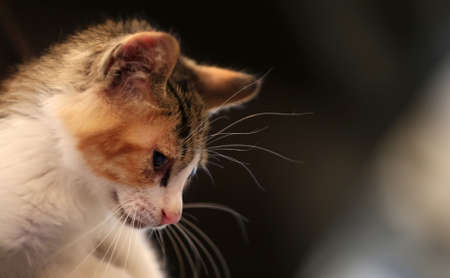1. What Is Kneading?
Kneading is a common behavior seen in cats, where they rhythmically push their paws in and out against a soft surface, such as a blanket, pillow, or even their owner’s lap. This motion often resembles the kneading of dough, which is why its commonly referred to as “kneading.”
The Rhythmic Motion of Kneading
Each cat has its own unique way of kneading. Some use both front paws in a steady, alternating pattern, while others may only use one paw at a time. The intensity also varies—some cats press gently, while others push with noticeable force and even extend their claws.
Variations Among Cats
Not all cats knead in the same way or for the same duration. Here’s a look at some common variations:
| Kneading Style | Description |
|---|---|
| Gentle Paws | A soft and slow motion without extending claws. |
| Deep Pressing | A strong push with extended claws, sometimes accompanied by purring. |
| One-Paw Kneading | Kneading with just one paw instead of both. |
| Kneading While Standing | The cat remains standing while performing the motion. |
| Kneading Before Sleeping | A ritual many cats perform before settling down to rest. |
2. Instinctual Behavior from Kittenhood
Have you ever noticed how kittens knead their mothers belly while nursing? This adorable action is actually an instinct that starts in kittenhood. When newborn kittens nurse, they use their tiny paws to push against their mother’s belly to stimulate milk flow. This rhythmic motion helps them get the nourishment they need and creates a strong sense of comfort and security.
Kneading as a Comforting Habit
Even after kittens grow into adult cats, this kneading behavior often remains. Since it was associated with warmth, safety, and nourishment during kittenhood, many cats continue to knead well into adulthood as a way to relax and soothe themselves. You might notice your cat kneading when they’re feeling particularly cozy, such as when they curl up on your lap or a soft blanket.
Why Do Some Cats Knead More Than Others?
Not all cats knead at the same frequency or intensity. Some will knead often, while others may do it only occasionally. The reasons for this can vary based on individual personality, past experiences, and levels of comfort in their environment. Here’s a quick comparison of different kneading behaviors:
| Kneading Behavior | Possible Reasons |
|---|---|
| Frequent and strong kneading | Cat feels very secure and comfortable; may have been weaned later as a kitten. |
| Occasional gentle kneading | Cat enjoys kneading but doesn’t rely on it as much for comfort. |
| No kneading at all | Some cats naturally don’t develop this habit or may prefer other ways to self-soothe. |
What If My Cat Kneads Too Much?
If your cats kneading becomes excessive or includes claws that are too sharp, there are ways to manage it. Keeping their nails trimmed can help prevent discomfort for both you and your furniture. Providing soft blankets or pillows can also encourage them to knead on designated areas instead of your lap.
Encouraging Healthy Kneading Habits
If your cat enjoys kneading, it’s usually a sign that they feel happy and safe around you. Letting them engage in this natural behavior is important for their well-being. Just be sure to provide soft surfaces where they can comfortably express themselves without causing damage or discomfort.
Understanding that kneading originates from kittenhood helps explain why so many cats continue this behavior throughout their lives. It’s not just cute—it’s a deeply ingrained instinct that brings them comfort and reminds them of the security they once felt as tiny kittens.
![]()
3. Marking Territory and Scent Glands
Have you ever noticed your cat kneading a blanket, your lap, or even a piece of furniture? While this behavior may seem random, theres actually a deeper reason behind it. Cats have scent glands located in their paws, and when they knead, they release pheromones that help them mark their territory. This behavior reinforces their sense of security and comfort in their environment.
How Do Scent Glands Work?
Cats have specialized scent glands in various parts of their bodies, including their cheeks, forehead, tail base, and paws. These glands secrete pheromones—chemical signals that communicate information to other cats. When your cat kneads an object, they are leaving behind these scent markers, essentially claiming the spot as their own.
Common Locations of Cat Scent Glands
| Body Part | Purpose of Scent Marking |
|---|---|
| Paws | Marks territory while kneading |
| Cheeks | Makes objects familiar by rubbing against them |
| Forehead | Sends calming signals to other cats |
| Tail Base | Used for scent marking during social interactions |
Kneading as a Comforting Behavior
This territorial marking is not just about dominance—it also provides cats with a sense of security. By surrounding themselves with their own scent, they create an environment where they feel safe and at ease. This is why many cats will knead when they are relaxed or preparing to settle down for a nap.
Why Does My Cat Knead Me?
If your cat kneads you, take it as a compliment! They are marking you as part of their trusted space and showing affection. Since kneading is often associated with comfort from kittenhood (when kittens knead their mothers belly for milk), adult cats continue this behavior when they feel content and close to their human companions.
4. A Sign of Comfort and Affection
One of the most heartwarming reasons cats knead is that it’s a sign of comfort and affection. When your cat presses its paws rhythmically against you, a blanket, or a soft surface, it’s often an indication that they feel safe and content.
Kneading as a Comforting Behavior
Cats tend to knead when they are in a relaxed state. This behavior is commonly seen when they are preparing to rest or settling into a cozy spot. The rhythmic motion may help them self-soothe, similar to how humans might fidget with objects when feeling relaxed.
An Expression of Affection
If your cat kneads on you, take it as a compliment! Cats often knead their favorite humans as a way of showing love and trust. This behavior originates from kittenhood, where they kneaded their mother while nursing. As adults, they transfer this affectionate action to their trusted human companions.
Common Signs Your Cat is Kneading for Affection
| Sign | What It Means |
|---|---|
| Purring while kneading | Your cat is extremely content and happy. |
| Kneading on your lap | A sign of love and attachment to you. |
| Kneading followed by curling up | Your cat feels completely safe and ready to rest. |
| Kneading with claws extended | An instinctive habit, though sometimes unintentionally painful! |
How to Encourage Gentle Kneading
If your cat tends to knead with sharp claws, consider placing a soft blanket on your lap to protect yourself. Regular nail trimming can also help reduce any discomfort while still allowing your cat to express their affection freely.
5. How to Respond to Kneading Behavior
Cats knead for various reasons, and while this behavior is generally harmless, it can sometimes be uncomfortable for pet owners or lead to damage to furniture. Understanding how to manage your cat’s kneading can help create a comfortable environment for both you and your feline friend.
Encouraging Positive Kneading Behavior
If your cat enjoys kneading, there are ways to encourage this behavior while ensuring it remains gentle and non-destructive:
- Provide a Designated Kneading Spot: Place a soft blanket or pillow in your cat’s favorite kneading spot to protect surfaces and keep them comfortable.
- Use a Kneading Mat: Special kneading mats or soft fabric items can give your cat an appropriate surface to express their natural instincts.
- Reinforce Positive Behavior: If your cat kneads on an appropriate surface, reward them with gentle petting or treats to encourage the habit.
Protecting Your Furniture
Kneading can sometimes lead to scratches on furniture or clothing. Here are some ways to prevent damage:
| Issue | Solution |
|---|---|
| Cats kneading on couches or beds | Place a thick blanket over areas where they like to knead. |
| Kneading with sharp claws | Trim your cat’s nails regularly to reduce scratching. |
| Kneading on sensitive skin | Praise them gently while redirecting their paws to a softer surface. |
Making Kneading Comfortable for Your Cat
Your cat’s comfort is just as important as protecting your belongings. Here are some ways to ensure they feel safe while kneading:
- Create a Cozy Environment: Provide soft bedding or heated pads in their favorite spots.
- Avoid Discouraging Kneading Harshly: Never punish your cat for kneading; instead, guide them toward better alternatives.
- Acknowledge Their Need for Comfort: If your cat kneads on you, consider placing a soft towel between them and your skin for added cushioning.
Kneading is a natural and instinctive behavior for cats. By understanding how to manage it effectively, you can ensure that both you and your feline companion remain happy and comfortable.


